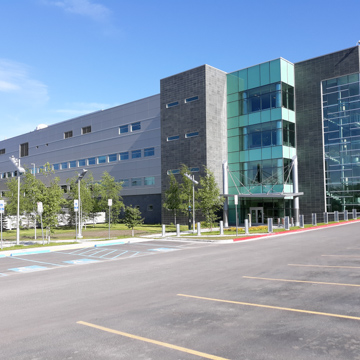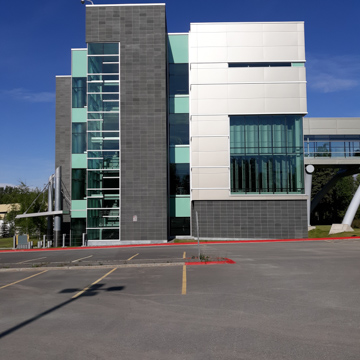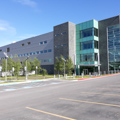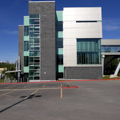The University of Alaska Anchorage opened its Engineering and Industry Building (EIB) in 2015, replacing a generation-old building that had become outdated and unable to accommodate the growing enrollment in the university's Engineering program. With over 75,000 square feet of lab and classroom space for the eleven disciplines within the college, the EIB nearly doubles the space of the former building. The EIB houses programs and courses related to arctic, mechanical, electrical, and civil engineering, as well as geomatics (surveying and map-making) and computer systems engineering. In addition to classrooms and meeting spaces, the building contains computer-aided design (CAD) labs, prototyping labs with 3-D printers, and dedicated space for project engineers and architects.
The building sits directly across the street from the university’s Health Sciences Building and is connected to it via the Parrish Bridge, which extends over Providence Drive, the university’s primary thoroughfare. The bridge doubles as a covered space for which students and faculty can not only change buildings but also use the space for study and socializing. Like the Health Sciences Building, the EIB is also constructed of metal paneling, steel, glass, and stone and bears a striking resemblance to it. Measuring eighty feet wide and 320 feet high, the EIB is one of the most imposing buildings on campus. Its color scheme—green trim and silver-grey metal panels—aligns with the Health Sciences Building but also the ConocoPhillips Integrated Science Building and the UAA/APU Consortium Library. But unlike those buildings, architecture firm Livingston Slone opted to expose the EIB's HVAC system as a learning tool for students and faculty. Beyond the HVAC system, other engineering features are visible with the expectation that they will serve an educational function. The sensors and accelerometers installed to detect seismic activity, tilt, or wind load are two additional examples. The building also contains reinforced flooring to hoist moving equipment with a 10-ton crane and to support structural testing. The building is outfitted with large interdisciplinary lab space, uniquely designed for students who wish to prepare for national and international engineering competitions.
The total project cost to upgrade the university's engineering facilities was $123.2 million, a figure that included funds to construct the new EIB, renovate and bring up to date the old engineering building for continued use, and erect a new parking garage to serve students, faculty, and staff in the College of Engineering. The new garage is located on campus a block to the northeast of the EIB. This was the final building constructed during what was a period of rapid expansion at the University of Alaska Anchorage between 2000 and 2015.
References
Kathleen McCoy, "UAA's Engineering and Industry Building delivers a living laboratory for students." Anchorage Daily News, January 18, 2014.

















